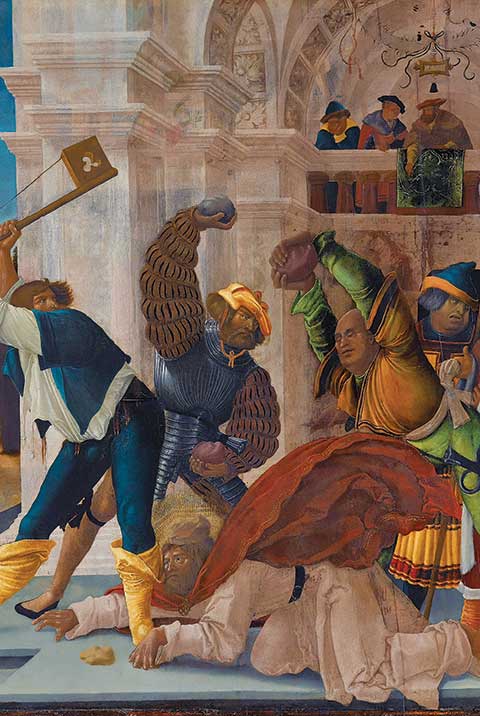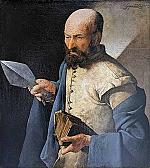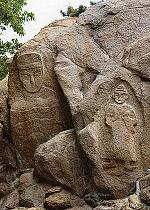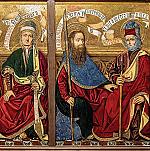Sons of Alphaeus

[ABOVE: Master of the Oberaltaicher “Man of Sorrows”, The Martyrdom of the Apostle James the Lesser, 1518. Paint on Spruce Wood—Public domain, Staatsgalerie Stuttgart]
Brothers abounded among Jesus’s earliest disciples, most notably Peter and Andrew and the sons of Zebedee. According to Eastern Orthodox tradition, another pair of brothers features in the crew of apostles: Matthew, also called Levi, and James the Lesser. James is called the son of Alphaeus in all four New Testament lists of the Twelve. While this definitely distinguishes him from James the son of Zebedee and James the half-brother of Jesus, it also associates him with the better-known Matthew who is called Levi the son of Alphaeus in Mark 2:14.
Scholars debate whether Matthew and James shared the same father named Alphaeus, and the evidence is scant. Like Peter and Andrew and James and John, Matthew’s name is listed adjacent to James’s in Matthew 10:3 and Acts 1:13. This pattern is not matched in Mark’s and Luke’s lists, though, and James the son of Alphaeus is always listed ninth in the pairings of the Twelve, whereas all four lists pair Matthew adjacent to Thomas. While it could be reasoned that Matthew and James were brothers and Matthew was closely associated as a ministry partner with Thomas (cf. Luke 10:1), most Western historians have concluded it more probable that the two were not brothers at all. Even still the stories of Matthew and James reinforce the same conclusion for believers today: Jesus called and used all sorts of people.
TAX COLLECTOR TO EVANGELIST
We know the name Matthew from the Gospel attributed to that disciple, who was called by Jesus while at work: “As Jesus passed on from there, he saw a man called Matthew sitting at the tax office; and he said to him, ‘Follow me’” (Matt. 9:9). In Mark and Luke, Matthew is first described by his given Jewish name, Levi (Mark 2:13–14; Luke 5:27–28). The fact that Mark and Luke use the name “Matthew” in their apostle lists after describing Jesus calling “Levi” the tax collector may mean that Jesus gave him the name Matthew (meaning gift of the LORD) to demonstrate his transformation.
In all three of the calling passages, Matthew responded to Jesus’s call by immediately hosting him in his home along with many friends who were also “tax collectors and sinners.” While the Gospel authors report the Pharisees’ consternation at Jesus’s table-fellowship in this episode, Matthew’s place among the disciples became a constant sign that Jesus accepted reviled people among his closest followers. The Pharisees’ disgust continued throughout Jesus’s ministry because of the social stigma placed on Jews who served the Romans (they subjected their fellow Jews to fines and fees for the occupying government). Tax collectors were also known to be selfish and oppressive in their own right. For example Zacchaeus admitted to defrauding others through his profession (Luke 19:8). Calling a tax collector like Matthew into his inner circle was a clear sign that Jesus came for those who would repent, leave behind the things of this world (cf. Luke 5:28), and serve the Kingdom of God.
Ironically Matthew’s experience as a tax collector likely helped when it came to his greatest contribution to the church, his Gospel. As a tax collector, he would have been skilled in taking notes quickly, which helped assure faithful records of Jesus’s sermons and parables. According to the accounts of church fathers such as Papias of Hierapolis, Eusebius of Caesarea, and Jerome, Matthew spent many years in Israel and Syria, writing his Gospel with a Jewish audience in mind. In fact Irenaeus of Lyons reported that “Matthew also issued a written Gospel among the Hebrews in their own dialect.” It is possible, then, that Matthew wrote his Gospel in the Aramaic language of the people of Palestine before it was then translated into the Greek lingua franca of the East.
MARTYRED, PROBABLY…BUT WHERE?
The trajectory of Matthew’s life and ministry after his time in Israel and Syria is much in doubt. Several stories have contradictory endings set in numerous locations: Egypt and Ethiopia, Parthia and Persia. In the Jewish Talmud, we find a late account that Matthew never left Israel and was condemned and executed by the Sanhedrin.
Socrates Scholasticus claimed in his fifth-century work, Ecclesiastical History, that Matthew was assigned by lot to evangelize Ethiopia. In the Apostolic History of Abdias, purportedly written by the bishop of Babylon in the first century, Matthew traveled to Ethiopia, where he encountered the eunuch converted and baptized by Philip the Evangelist (Acts 8:26–40). When King Aeglippus’s son died, Matthew raised him from the dead. As a result Matthew baptized the king and all his family. The apostle supposedly ministered there for 23 years, raising up the Church of the Resurrection in Ethiopia, planting other churches, and ordaining clergy. Aeglippus, however, was succeeded by his brother Hyrtacus, who demanded that his niece Ephigenia should marry him. Having taken vows of virginity, she opposed her uncle, and Matthew preached against such an incestuous act. In retaliation Hyrtacus commanded a soldier to pierce the apostle with a spear.
Other accounts placed Matthew in Parthia, or Persia. The Acts and Martyrdom of Matthew detailed the apostle’s sojourn to a city of cannibals, where a demon-possessed king nailed him to the ground and set him on fire. The fire took on the appearance of a dragon that chased the king, but even though Matthew commanded the fire to spare the king, the apostle was burned to death. Subsequently a vision that showed Matthew receiving his crown of martyrdom inspired the conversion of the king.
Abdias’s Conflicts of the Holy Apostles reported that a wicked man came to the Parthian city in which Matthew was serving, and he accused Matthew of ruining the city with his preaching about Jesus of Nazareth. Believing these false accusations, the king sent soldiers to behead Matthew, cut up his body, and scatter it as food for the birds.
Yet one more account of Matthew in Parthia was provided by Hippolytus of Rome in his treatise, On the Twelve Apostles. Of Matthew, Hippolytus briefly stated that after the apostle published his Gospel, he “fell asleep at Hierees, a town of Parthia.” The implication here was that Matthew simply died of natural causes.
In light of so many contradictory accounts of Matthew’s life, all we can conjecture is that he obeyed the Great Commission with which he concluded his own Gospel.
LESS ABOUT JAMES THE LESSER
If some testimonies of Matthew’s ministry are contradictory, the situation is even more complicated for James. While we see Matthew featured in one Gospel narrative (his calling), James is hardly ever mentioned by name. Tradition usually identifies James the son of Alphaeus with James the Lesser (or Younger, see Mark 15:40), a name he was given to contrast with James the son of Zebedee, who appears more prominently in the Gospels together with his brother John.
Church fathers Papias of Hierapolis and Jerome deduced that James the son of Alphaeus was the first cousin of Jesus on the basis that James’s mother was the sister of Jesus’s mother (see pp. 50–53). Although James the son of Alphaeus was clearly distinguished from James the son of Zebedee, stories regarding James the Lesser seem to have been conflated with the story of James the Just, the half-brother of Jesus. Multiple accounts describe a martyrdom of James the Lesser similar to that of James the Just: stoned by enraged Jews near the Jerusalem Temple. According to Abdias of Babylon, writing in his Conflicts of the Holy Apostles, James the Lesser came to Jerusalem and preached the gospel to the people assembled at the temple:
James, the son of Alphaeus, spoke many things, and declared the faith in the only Begotten Son, the true Word of God, who was from all eternity Jesus Christ the Son of God in truth; for He was with the Father, and He is the Word of the Father. The Apostle spoke thus in the midst of the assembled people without fear of anyone.
Later traditions placed James the Lesser in Persia and Egypt, but these seem even less reliable. It appears that in his relative anonymity, any confidence about James’s ministry and martyrdom has been lost to confusion.
SURPRISING SERVANTS
The stories of some apostles are hazy, but we can have confidence in the calling of Jesus. In the case of the two sons of Alphaeus, we see that Jesus called the unexpected, like Matthew, and the unknown, like James. Not all of Jesus’s disciples have miraculous or momentous testimonies, and not all have clear martyrdom traditions. Yet every person called by Christ, no matter their history or personality, can be used in the service of the Kingdom of God. Matthew was reviled by Jesus’s opponents because of his background and colleagues. James was forgotten or confused with others. Yet these same brothers, in Christ at least, were counted worthy to be sent out by Jesus, to see him resurrected, and to take the gospel into the world. CH
By Thomas G. Doughty Jr.
[Christian History originally published this article in Christian History Issue #156 in 2025]
Thomas G. Doughty Jr. is assistant professor of theology and worldview at New Orleans Baptist Theological Seminary, associate dean of Leavell College, and editor of Journal for Baptist Theology and Ministry.Next articles
“Doubting” or “daring” Thomas?
History’s most famous doubter recovered his faith and pioneered a bold mission to the East
Bryan M. LitfinCourage, zeal, and faithfulness
Accounts of Judas Thaddeus, Simon the Zealot, and Matthias help explain the Gospel’s far reach
Rex D. ButlerSupport us
Christian History Institute (CHI) is a non-profit Pennsylvania corporation founded in 1982. Your donations support the continuation of this ministry
Donate







